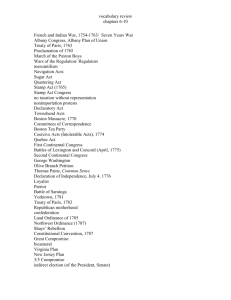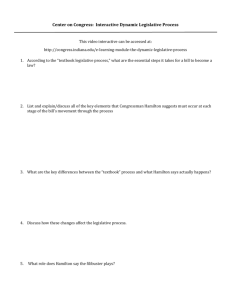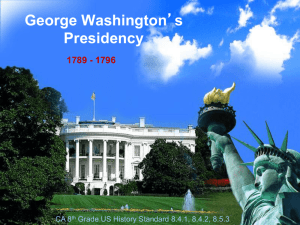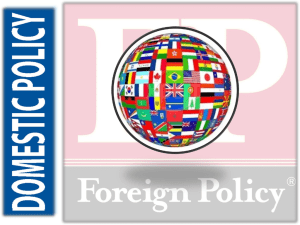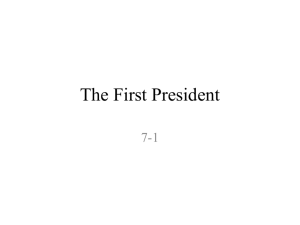Vocab 7 - Washington and Hamilton
advertisement
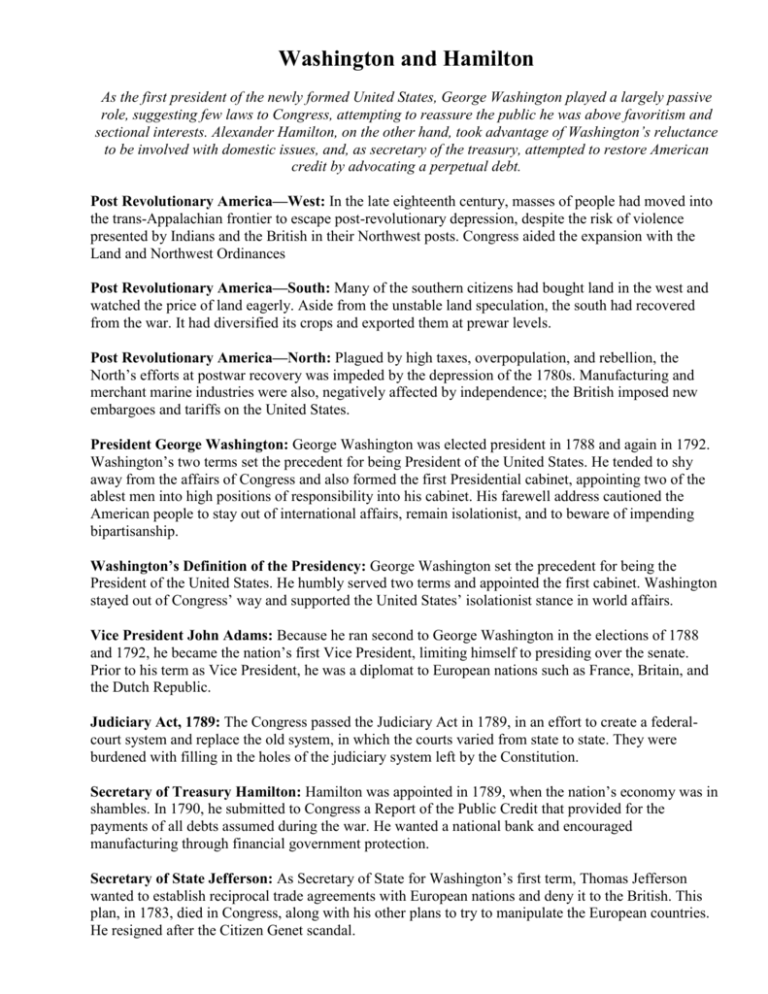
Washington and Hamilton As the first president of the newly formed United States, George Washington played a largely passive role, suggesting few laws to Congress, attempting to reassure the public he was above favoritism and sectional interests. Alexander Hamilton, on the other hand, took advantage of Washington’s reluctance to be involved with domestic issues, and, as secretary of the treasury, attempted to restore American credit by advocating a perpetual debt. Post Revolutionary America—West: In the late eighteenth century, masses of people had moved into the trans-Appalachian frontier to escape post-revolutionary depression, despite the risk of violence presented by Indians and the British in their Northwest posts. Congress aided the expansion with the Land and Northwest Ordinances Post Revolutionary America—South: Many of the southern citizens had bought land in the west and watched the price of land eagerly. Aside from the unstable land speculation, the south had recovered from the war. It had diversified its crops and exported them at prewar levels. Post Revolutionary America—North: Plagued by high taxes, overpopulation, and rebellion, the North’s efforts at postwar recovery was impeded by the depression of the 1780s. Manufacturing and merchant marine industries were also, negatively affected by independence; the British imposed new embargoes and tariffs on the United States. President George Washington: George Washington was elected president in 1788 and again in 1792. Washington’s two terms set the precedent for being President of the United States. He tended to shy away from the affairs of Congress and also formed the first Presidential cabinet, appointing two of the ablest men into high positions of responsibility into his cabinet. His farewell address cautioned the American people to stay out of international affairs, remain isolationist, and to beware of impending bipartisanship. Washington’s Definition of the Presidency: George Washington set the precedent for being the President of the United States. He humbly served two terms and appointed the first cabinet. Washington stayed out of Congress’ way and supported the United States’ isolationist stance in world affairs. Vice President John Adams: Because he ran second to George Washington in the elections of 1788 and 1792, he became the nation’s first Vice President, limiting himself to presiding over the senate. Prior to his term as Vice President, he was a diplomat to European nations such as France, Britain, and the Dutch Republic. Judiciary Act, 1789: The Congress passed the Judiciary Act in 1789, in an effort to create a federalcourt system and replace the old system, in which the courts varied from state to state. They were burdened with filling in the holes of the judiciary system left by the Constitution. Secretary of Treasury Hamilton: Hamilton was appointed in 1789, when the nation’s economy was in shambles. In 1790, he submitted to Congress a Report of the Public Credit that provided for the payments of all debts assumed during the war. He wanted a national bank and encouraged manufacturing through financial government protection. Secretary of State Jefferson: As Secretary of State for Washington’s first term, Thomas Jefferson wanted to establish reciprocal trade agreements with European nations and deny it to the British. This plan, in 1783, died in Congress, along with his other plans to try to manipulate the European countries. He resigned after the Citizen Genet scandal. Secretary of War Knox: Henry Knox was the Secretary of War from 1789-1794, the first one under the United States Constitution. Prior to this, he fought in major Revolutionary battles, was in command of the West Point fortress in New York, and was the Secretary of War under the Articles of Confederation. Attorney General Randolph: Edmund Jennings Randolph was the Attorney General under the Washington Administration from 1789-1794; before which he was the head of the Virginia delegation at the Constitutional Convention in Philadelphia and submitted the Virginia Plan. Hamilton’s program: ideas, proposals, reasons for it: Alexander Hamilton wrote to Congress a Report on Public Credit which proposed a way in which the national and foreign debts could be funded and how the federal government would take charge of the debts left by states from the resolution in 1790. The plans attempted to end wartime debt problems. Hamilton believed that constant deficit was necessary to stimulate the nation’s economy, and also believed that the U.S. should immediately repay its foreign debt. Tariff of 1789: A revenue raising tariff enacted by Congress, it encouraged the people of the U.S. to manufacture earthenware, glass, and other products in their home in order to avoid importation. With a duty of 8.5%, the tariff succeeded in raising much needed funds for Congress Bank of the U.S.: Chartered by the newly formed federal government, the bank was established in Philadelphia in 1791, and was permitted by the government to issue legal tender bank notes that could be exchanged for gold. The bank successfully established a national currency, but the charter ended in 1811, for economic and political reasons. excise taxes: A fixed charge on items of consumption, usually used for revenue raising. The first excise tax placed upon the United States in 1791, by Parliament was one which taxed all domestic distilled spirits. Anger towards this excise tax led directly to the Whiskey Rebellion. Report on Public Credit: Hamilton submitted his report to Congress in 1790, hoping to seize it as an opportunity to rebuild the country’s credit base. He reported that the US was 54 million dollars in debt: 12 million to foreigners, and the rest to Americans. On top of that, he estimated that the states held debts of over 25 million dollars. Location of the capital: logrolling, D.C.: The nation’s capital was originally located in New York, but later was transferred to Washington D.C.. Originally planned by Charles L’Enfant, the city consisted of beautiful walkways, tree lined streets, and masterfully architecture buildings. Indian Decline: The frontier warfare during the post-revolutionary era combined with the continuing penetration of western ways into Indian culture caused severe reductions in Indian population and territory. An increasing amount of hatred towards the "redskins" further encouraged the violence towards Indians. Residence Act: Determined that a ten mile square area for the capital of the United States would be chosen along the Potomac River along the Virginia-Maryland boarder. The area was to be named the District of Columbia, after Christopher Columbus, and was selected by George Washington. Whiskey Rebellion: An organized resistance in 1794, to the excise tax on whiskey in which federal revenue officials were tarred and feathered, riots were conducted, and mobs burned homes of excise inspectors. The federal militia captured many of the protesters, but most were released. French Alliance of 1778: Alliance made between France and the United Sates during America’s civil war in 1778. The alliance was used to convince French citizens living in United States territory to become citizens of American, and therefore to bear arms or participate in the war. French Revolution: The revolution was a period consisting of social and political upheaval from 17891799. Caused by the inability of the ruling class and clergy to solve the states problems, the hunger of the workers, the taxation of the poor, and the American Revolution, it led to the establishment of the First Republic and the end of the monarchy. Citizen Genet: Sent to the United States by the French in 1793 to find soldiers to attack British ships and conquer the territories held by the Spanish, Edmund Genet founded the American Foreign Legion despite Washington’s April 22 proclamation of American neutrality. Neutrality Proclamation: Issued by President George Washington on April 22, 1793, the Neutrality Proclamation stated that the United States would remain a neutral faction in the war with France against Britain and Spain despite heavy French pressures to join their forces. Many Americans felt the war to be a violation of their neutrality. XYZ Affair, Talleyrand: When a commission was sent to France in 1797 in order to negotiate problems between the two countries, they were told by the French foreign minister Talleyrand that the agents X, Y, Z, three officials who did not take the process seriously, would only negotiate for a lend of $10 million to the French government. Undeclared Naval War with France: Otherwise known as the Quasi-War, the undeclared conflict between the two nations lasted from 1798 to 1800. In the conflict, the United States managed to capture ninety-three French ships while France captured just one U.S. ship. British Seizure of American Ships: The Privy Council issued a secret order on November 6, 1793, to confiscate any foreign ships trading with French Caribbean islands. In this decision, they seized over 250 American ships which were conducting trade with the islands. Royal Navy: They navy of the British empire, the Royal Navy began to inspect American ships in 1793 for suspected defects of the British Navy, who they then forcibly placed back into their own navy. These bold actions commonly referred to as impressment, further strengthened hostilities between the two countries. Jay’s Treaty: Negotiated between the United States and France in 1794, the treaty evacuated British posts in the West, appointed a committee to set up the U.S.-French boundary, and named a commission to determine how much the British should pay for illegally seizing American ships. It did not resolve the British West Indies trade dispute. "Mad" Anthony Wayne: Known as Mad Anthony due to his quick temper and his bravery, Wayne was a General during the American Revolution. He began his service with the Pennsylvania militia. He participated in the battles of Brandywine and Germantown and distinguished himself in the Battle of Monmouth. Battle of Fallen Timbers: At the Battle of Fallen Timbers, in 1794, Anthony Wayne defeated a coalition of Native American tribes as the major general and commander in chief of the troops. The battle took place around present day Toledo and led to the Treaty of Greenville which opened up the Northwest to American settlers. Treaty of Greenville, 1795: This treaty, which was drafted in 1795, opened the Northwest Territory to settlement by white United States citizens. The territory had formerly only been inhabited by Indians, so therefore the treaty between the two races was an important one. The treaty served to end white-Indian hostilities for sixteen years. Barbary Pirates: Following the American Revolution, the Barbary pirates began to raid the ships of the United States. The United States therefore formed treaties with Morocco, Tripoli, and Tunis, as European nations already had, that gave them immunity from these attacks. Tripolitan War: From 1801-1805, the war was a battle between the North African state Tripoli and the United States. The Tripolitans had seized U.S. ships in the U.S. refusal to pay in increase in the tribute paid to the pasha of Tripoli. In the end, the demand for payment was ended and the U.S. paid $60,000 to free Americans caught captive. Washington’s Farewell Address: In his realization of the important role that he had take in developing the role of the president of the United States, Washington’s farewell address asked the citizens of the United States to avoid involvement in political problems between foreign nations.
